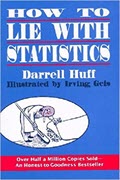We are bombarded with factoids and sound bites in political speeches, subway ads, water-cooler conversations—everywhere. It takes a sharp focus to separate the babble from the facts. For guidance with this important task, I recommend Darrell Huff’s classic book, How to Lie with Statistics.
Some people might be put off by such a mathematical subject. But if you learned in grade school how to calculate an average and a percentage, you have sufficient math background to enjoy and appreciate this book. Huff gives the layman the essential knowledge he needs “to look a phony statistic in the eye and face it down; and no less important . . . to recognize sound and usable data in that wilderness of fraud to which [this book is] largely devoted.” He achieves his goal in a brief 142 pages, using many amusing examples and a sprinkling of clever cartoons which capture the point and the humor of the prose.
Huff explains key concepts in statistics in simple terms, then shows how they are misused. For instance, he explains an “unbiased sample,” and then recounts this story illustrating the difficulty of getting unbiased data: A firm surveyed people to find what magazines they read, but the results were contradicted by the circulation statistics of the magazines. “About all the survey had uncovered was snobbery,” Huff concluded. People reported reading high-brow magazines (that in fact, had low circulations) and didn’t report reading low-brow ones (that did have high circulations).
In another section he points out how statistics can be used to disguise a bait-and-switch operation. As a simple example, suppose “you can’t prove your nostrum cures colds, but you can publish (in large type) a sworn laboratory report that half an ounce of the stuff killed 31,108 germs in a test tube in eleven seconds.” The unwary reader will think this statistic impressive, although it shows nothing about the product’s efficacy in the human throat. As Huff says later about another spurious statistic, “the only answer to a figure so irrelevant is, ‘so what?'”
In addition to explaining statistical concepts and analyzing specific examples, Huff encourages the layman to ask logical questions to check the validity of a claim supposedly based on statistical data. Such questions as “Who says so?” and “How does he know?” help you maintain a proper skepticism when you read about a new investment strategy that has been “statistically proven” to double your money in two years, or a poll purporting to disprove what everyone knows to be true.
Taken altogether, this short book is a lesson in how to mobilize your common sense to evaluate claims based on statistics. It’s an excellent, essentialized primer, which I re-read every five or ten years. When I’m finished, I feel re-armed to seek out the truth behind any number thrown my way.
Book Information: Darrell Huff, How to Lie with Statistics. W. W. Norton & Company, 1993.









I like your blog